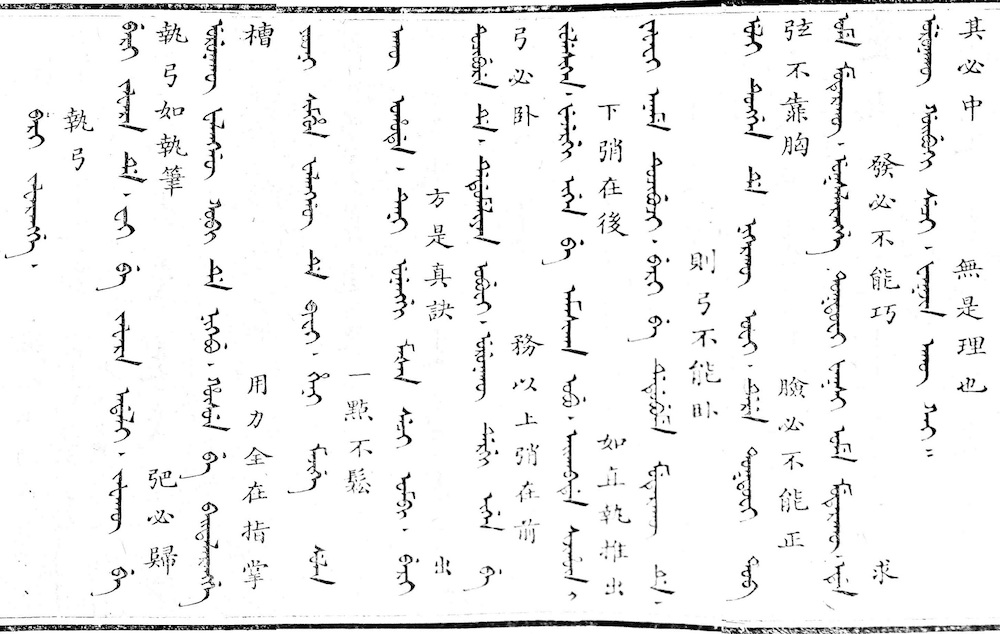Shedi 射的 (also called Shedishuo 射的說), Manchu name Gabtan-i jorin (i gisuren), is a bilingual book (hebi 合璧) on archery written by the Manchu Bannerman Canggiyūn (Ch. Changjun 常鈞, 1702-1789) in 1770. It is an essential text reflecting an integral part of the martial aspects of Manchu culture and was part and parcel of the Qianlong Emperor's 乾隆帝 attempts to revive and preserve Manchu virtues in an age when they were quickly declining. The title is translated as "Targets in shooting" (Eijk and Sam-Sin 2018) or as "Aims of archery" (Hudgins 2021).
 |
Chapter on holding the bow. As Manchu is the guiding language, the text begins to the left. The Chinese version is written in small characters to the right of Manchu words. See translation below. |
Canggiyūn was a descendant of the Yehe Nala clan 葉赫那拉 and was a member of the Bordered Red Banner (Manzhou xianghong qi 滿洲鑲紅旗). In 1726, he was appointed secretary of the Grand Secretariat (neige zhongshu 內閣中書). He was later transferred to the post of secretary in the Ministry of War (bingbu zhushi 兵部主事), which allowed him to carry out the function of Secretary in the Council of State (junji zhangjing 軍機章京). During the last Junggar war, he was made vice director in the Ministry of Works (gongbu yuanwailang 工部員外郎). In 1760, he was made Vice Commander-in-chief of the Chinese Plain White Banner (baizhengqi Hanjun fu dutong 正白旗漢軍副都統) but was elevated to Vice Minister of Justice (xingbu shilang 刑部侍郎) two months later. At the end of the same year, he took over the temporary function of governor (xunfu 巡撫 ) of Jiangxi, then of Anhui, Henan, and finally Gansu. After the final pacification of the Western region, Canggiyūn was made 雲騎尉. In the years to come, he was governor of Yunnan, then of Hunan, but was dismissed in 1766. He then took over the post of Amban (banshi dachen 辨事大臣) of Kašɣar in Xinjiang 喀什噶爾, then of Qarašahar 哈喇沙爾. In 1771, he returned to Beijing and was made imperial guardsman of the third rank (sandeng shiwei 三等侍衛).
His book was available both in print and as a manuscript. Copies are accessible in many libraries across China and Japan. The Manchu version is dominant, typically leading the Chinese text in the unusual order from left to right. The text comprises 13 chapters, namely:
| 1 | Gūnin be unenggi oburengge | 誠意 | Focusing your thought |
| 2 | Mujilen be tob oburangge | 正心 | Being upright on the inside |
| 3 | Simen be teburengge | 存神 | Keeping your spirit up |
| 4 | Sukdun be ujirengge | 養氣 | Regulating the airflow |
| Ilhi aname ibeme dosire oyonggo kemun | 入門次第節要 | The standard technique step by step | |
| 5 | Urebure arga | 演法 | Methods |
| 6 | Oksoro teisu ba | 步位 | Stance |
| 7 | Beri jafanarangge | 執弓 | Holding your bow |
| 8 | Niru solbirengge | 扣箭 | Nocking the arrow |
| 9 | Beri tatarangge | 開弓 | Drawing the bow |
| 10 | Kimceme toktoburengge | 審固 | Determination |
| 11 | Ashūme uksalarangge | 撒放 | The release |
| 12 | Beri be hūsun de acaburengge | 弓與力配 | Matching strength with the bow |
| 13 | Kacilan be beri de acaburengge | 矢與弓配 | Matching the bow with the arrow |
| app. | Ioi Yang ni gabtara yafan de morin be tuwaha nirugan de araha gisun | 榆陽射圃觀馬圖說 |
There is an appendix explaining the skill of shooting from horseback, as well as the inspection of horses.
The text of the Gabtan-i jorin strongly resembles Gu Gao's 顧鎬 Sheshuo 射說, and it is therefore very probable that the latter was the model for Canggiyūn's book. Even if the book primarily focuses on the martial aspect of archery, cultural and ceremonial elements are not missing. It might even be said that while Li Chengfen's 李呈芬 Shejing 射經 and Li Shugu's 李恕谷 (Li Gong 李塨, 1659-1733) Xueshelu 學射錄 focused only on the skill of archery, Gu's Sheshuo and the Gabtan-i jorin expounded the "way" (dao 道) of archery.
| Manchu version |
| Beri jafara de . fi be jafara adali . jafakū be urunakū falanggū kobi de nikebu . hūsun be baitalarangge yooni simhun falanggū de bifi . heni majige sula akū ohode . teni unenggi mašan seci ombi . beri tucibure de . dedumeliyan obufi . urunakū dergi igen be julesiken . fejergi igen be amasikan obu . aikabade sijihūn i jafafi aname tucibufi . beri be dedubume muterakū de . uli tunggen de nikerakū ofi . derei toktofi tob, ume muterakū . uksalarangge toktofi faksi ume muterakū . ede, urunakū goibuki seci . fakjin akū kai : |
| Chinese version | 執弓如執筆,弝必歸槽,用力全在指掌,一點不鬆,方是真訣,出弓必臥,務以上弰在前,下弰在後,如直執推出,則弓不能臥,弦不靠胸,臉必不能正,發必不能巧,求其必能中,無是理也 。 |
| English translation | Holding your bow is like holding a brush. You must lay its grip in the centre groove of your palm. Using strength, grip the bow with your fingers and the face of your palm. Hold on tight, so you can act fast when needed. Taking out your bow to take position, cant it a bit. Make the upper ear of the bow tilt forward, and the lower ear backward. If you do not cant the bow, the string will not make contact with your torso, making it impossible to align your sight with the arrow, and [also] impossible to use the right technique in your release. Anyone who insists that he can hit the target like this is just lying. |
Translation from Eijk and Sam-Sin 2018. Original text from Manc.hu (https://manc.hu/en/tools/reader/text/4527/08-gabtan-i-jorin) |